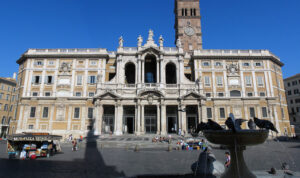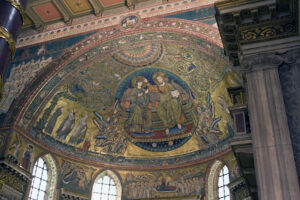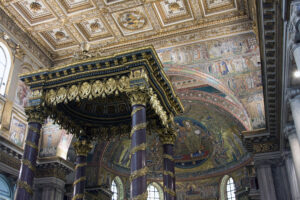Another article in an occasional series on the history of Rome.
Founding and Construction

Santa Maria Maggiore (St Mary Major) is one of 4 papal basilicas in Rome. The others are:
San Giovanni in Laterano (St John in the Lateran)
San Paolo Fuori le Mura (St Paul Outside the Wall)
San Pietro in Vaticano (St Peter in the Vatican)
It is one of the 4 churches the Pope holds Mass in and each church’s plot of land is a little piece of the Vatican.
Construction
Built in 8 years from 432 to 440, Santa Maria Maggiore sits on the summit of the Esquiline Hill, on a place that legend says was the location of an August snowstorm in 358. A childless couple was visited by the Virgin during their sleep and were told to build a church on the spot where snow fell the next morning. This led to the church first being called Santa Maria della Neve (St Mary of the Snow). Every year in August the legend is re-enacted by Rome Catholics who drop white flower petals from the dome during the feast day festival.
Over the centuries the church was expanded and remodeled but its interior remains true to its original construction; its layout looks very much like a 1st century Roman basilica, which for them was not a church but in fact a shopping mall/civic center building. It has a long tall nave, two aisles (one on either side) and a semi-hemispherical dome at the far end. Its overall length is 92 m, its overall width is 80 m and the nave is 30 m wide. It’s 75 m high. The ceiling is said to be gilded with gold brought back from the New World. The columns inside are recycled from an older Roman temple.
Mosaics and Art

Apse
The mosaics in this church are nothing less than spectacular and should be the main focus of a visit. The dominant work of art in Santa Maria Maggiore is doubtlessly the apse mosaic. Created in 1295, it features Jesus and Mary surrounded by representations of the Tree of Life, the Apostles and other liturgical symbols. A truly stunning work, it set the standard for representations of Mary in Catholic art for centuries.

Triumphal Arch
The Triumphal Arch is also similarly beautiful. It illustrates scenes from Christ’s life and its theme is The Infant Savior. Because these works are older than the Council of Nicea, the Triumphal Arch in this church includes a scene that didn’t make the cut in the official New Testament (Christ as a baby is brought to a temple but His holiness causes the temple statues to crack and fall from their pedestals). Thus Santa Maria Maggiore’s Triumphal Arch mosaic is the only example of Christian art that contains a scene of Christ’s life not in the Bible.
Nave
Standing in the back of the nave you can see directly above the columns and architraves and underneath each window mosaics of Old Testament history. Research has dated them to circa 432-440, in the pontificate of Pope Sixtus III. Since the natural light in the church is very low, the best way to see them is to be in the church just prior to a service. They are then lit with artificial light and they absolutely glow! Some of them were heavily restored with paint during the Middle Ages, and some were reconstructed in 1593 and later.
Of the original 42 panels, 27 have survived to today. Fifteen have been lost through the ages; some of those when the Pauline and Sistine Chapels were built (you can see the archways at the end of the nave built for their entrances).
Additions
The Sforza Chapel is interesting because Michaelangelo designed it in 1564 (and completed in 1573 by Giacomo della Porta). Because so many of his works are now “off limits” to the general public it is nice to be able to not only walk up to one of his creations but actually walk into one. The original entrance to this chapel was a large arch, but it was demolished in the mid-1700’s.
This church also has a Sistine Chapel, but this Sistine Chapel is nothing like the famous one in the Vatican. Any chapel built by a Pope named Sixtus (there were 5 of them) is named “Sistine.” Laid out in a Greek Cross plan with a magnificent dome capping it, the Sistine Chapel known officially as Blessed Sacrament Chapel is a truly outstanding creation. Domenico Fontana designed it and work began in 1585. It is the burial place of Pope Sixtus V.
My family is going to be in Rome on August 5 this year and would like to witness the dropping of the flower petals at Santa Maria Maggiore. I have a few questions: Are they dropped indoors or outdoors? What time of day does it occur? Does it occur at a mass? Is it an event that is open to the public? Thank you!
The ceremony is inside the church held during a Mass. There are a few videos of the event on YouTube; search YouTube for “santa maria maggiore august 5” and you’ll get a bunch of results.
Dear Mr Zeleznikar,
I couldn’t find your email address anywhere.
I’m a PhD student in Translation at the University of the Salento, Italy.
As part of my research project I’m downloading travelogues of Italy but I need to be aware of the nationality of all writers.
As I have read your travelogue on the Internet, I am writing to you to ask if you would answer these three short questions:
1. Where are you from?
2. Where do you live at the moment?
3. How old are you?
Your reply will be read only by myself and treated in confidence in any reporting of my research project. I shall send you a brief summary of my reaserch once it is completed (by May 2015).
Thanks a lot!
Best regards.
_______________________________
Angela
PhD Student – University of Salento